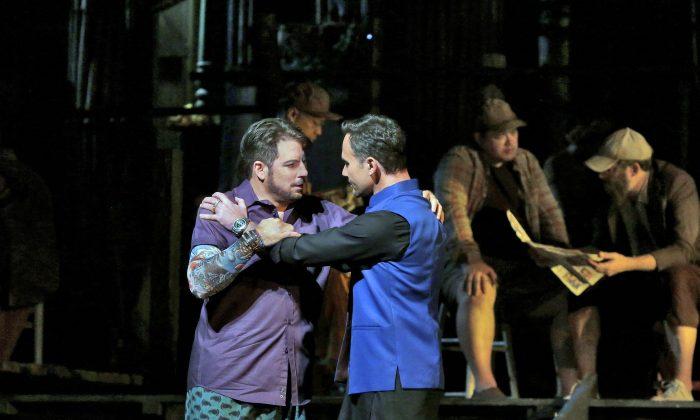NEW YORK—Georges Bizet’s “Carmen” is one of the most popular operas ever written. His earlier work “Les Pêcheurs de Perles” (“The Pearl Fishers”) has languished in relative obscurity, except for the famous duet and a tenor aria.
“The Pearl Fishers” is back at the Metropolitan Opera, where the work was last performed in 1916. Anyone seeing this wonderful staging (a co-production with the English National Opera) will wonder why it took so long to revive the opera.
The British director and filmmaker Penny Woolcock (who was born in an expatriate community in Argentina) is primarily known for tackling provocative modern pieces, such as “Doctor Atomic” (which she directed at the Met) and “The Death of Klinghoffer” as well as documentaries about dog fighting and street gangs.
The opera begins in spectacular fashion with the sight of pearl fishers swimming behind a scrim. Are they real or video projections? Actually both. The three dancers are on wires that the audience can’t see.

The opera was originally set in Ceylon (now Sri Lanka) in ancient times. The new production takes place in the Far East, though not in any specified location, and the time period is unclear.
The plot starts with the reunion of two fishermen, Nadir and Zurga, who had been friends since they were children. Zurga is the leader of the village and Nadir had been away for one year. They had both fallen in love with a Hindu priestess named Leila and vowed to relinquish their romantic inclinations.

According to village beliefs, only the virgin priestess can maintain the calm seas and keep the divers safe. When Leila appears (albeit veiled), Nadir recognizes her and their mutual love is instantly rekindled.
Between acts, there is a projected image of a tsunami.
The storm breaks out during the second act. Nourabad (the high priest) discovers the lovers and holds them responsible for the bad weather. Zurga appears to be sympathetic until he removes Leila’s veil and realizes that Nadir has broken his vow.

Zurga struggles with the thought that his former best friend and the woman he loved are about to be sacrificed. To save them, he sets the village on fire. At the end, Nadir and Leila escape while Zurga remains to face the music.
Granted, the plot (especially the ending) doesn’t make much sense. But this is an opera and audiences are tolerant when the music is sung and played this well.

The cast is outstanding: Tenor Matthew Polenzani is Nadir, baritone Mariusz Kwiecien is Zurga, soprano Diana Damrau is Leila, and bass-baritone Nicolas Testé is Nourabad. They are all credible actors and outstanding singers.
The famous tenor-baritone duet, “Au fond du temple saint,” is stirringly performed by Polenzani and Kwiecien, and the tenor delivers an ecstatic rendition of the difficult aria “Je crois entendre encore.”

The score also includes a beautiful soprano aria, “Comme autrefois,” and a love duet between Nadir and Leila. Damrau is as terrific here as she was as Manon last season.
The chorus (as the villagers) plays a vital role and is up to its high standards, and so is the orchestra under conductor Gianandrea Noseda.
Special credit to Woolcock and her superb design team: Kevin Pollard (costumes), 59 Productions (video projections), Jen Schriever (lighting), Dick Bird (set design), and Andrew Dawson (choreography). From the swimming figures at the beginning to the fires in the last scene, the visual effects add to the drama.
The production proves that this early Bizet work deserves to be performed regularly.
The Jan. 16 matinee will be transmitted live around the world as part of the Met’s Live in HD series.
‘The Pearl Fishers’
Metropolitan Opera
Tickets: 212-362-6000, or MetOpera.org
Closes: Feb. 4
Barry Bassis has been a music, theater, and travel writer for over a decade for various publications.






